Accounting of Grassland Ecosystem Assets and Assessment of Sustainable Development Potential in the Bosten Lake Basin
Abstract
:1. Introduction
2. Materials and Methods
2.1. Study Area
2.2. Data Sources
2.3. Grassland Classification
2.4. Evaluation of Grassland Ecosystem Service Value
2.5. Grassland Utilization Change Scenarios Based on the PLUS Model
2.5.1. Land Use Change Simulation
2.5.2. Different Scenario Settings Based on the PLUS Model
3. Results
3.1. Spatiotemporal Evolution of Grassland Type Changes and Ecosystem Service Value
3.1.1. Dynamic Changes in Different Grassland Types
3.1.2. Dynamic Changes in the Value of Grassland Ecosystem Services
3.2. Changes in Grassland Types and Ecosystem Services Under the PLUS Model
3.2.1. Simulation of Grassland Type Changes Under Multiple Scenarios
3.2.2. Characterizing Changes in the Value of Grassland Ecosystem Services Under Multiple Scenarios
4. Discussion
5. Conclusions
- From 2000 to 2022, the overall grassland area in the Bosten Lake Basin showed a declining trend. Analysis by grassland type revealed a pattern of “six increases and six decreases”. Increases were observed in plain desert steppe grasslands, hilly desert steppe grasslands, plain desert grasslands, hilly desert grasslands, mountain desert grasslands, and mountain desert steppe grasslands. Decreases were observed in plain meadow grasslands, plain typical steppe grasslands, hilly typical steppe grasslands, hilly meadow grasslands, mountain meadow grasslands, and mountain typical steppe grasslands.
- Grassland ESV demonstrated marginal fluctuations during the 22-year observation period, characterized by an initial decade of growth (2000–2010) succeeded by progressive decline through subsequent phases (2010–2022). Geospatial analysis revealed concentrated high-value clusters along the western, northern, and northeastern peripheries of the research basin.
- Compared to 2022, grassland degradation and area reduction were evident across all three future scenarios, with the primary conversions occurring among plain and hilly grassland types. The natural development scenario yielded the highest ESV for plain typical steppe grasslands; the economic priority scenario showed the greatest ESV decline compared to 2022, whereas the ecological protection scenario resulted in the highest ESV values overall.
Author Contributions
Funding
Institutional Review Board Statement
Informed Consent Statement
Data Availability Statement
Conflicts of Interest
References
- Li, T.; Cui, L.Z.; Lv, W.C.; Song, X.; Cui, X.; Tang, L. Exploring the frontiers of sustainable livelihoods research within grassland ecosystem: A scien-tometric analysis. Heliyon 2022, 8, e10704. [Google Scholar] [CrossRef] [PubMed]
- Bardgett, R.D.; Bullock, J.M.; Lavorel, S.; Manning, P.; Schaffner, U.; Ostle, N.; Chomel, M.; Durigan, G.; Fry, E.L.; Johnson, D.; et al. Combatting global grassland degradation. Nat. Rev. Earth Environ. 2021, 2, 720–735. [Google Scholar] [CrossRef]
- Grange, G.; Finn, J.A.; Brophy, C. Plant diversity enhanced yield and mitigated drought impacts in intensively managed grassland communities. J. Appl. Ecol. 2021, 58, 1864–1875. [Google Scholar] [CrossRef]
- He, M.; Pan, Y.; Zhou, G.; Barry, K.E.; Fu, Y.; Zhou, X. Grazing and global change factors differentially affect biodiversity-ecosystem functioning relationships in grassland ecosystems. Glob. Change Biol. 2022, 28, 5492–5504. [Google Scholar] [CrossRef] [PubMed]
- Zhu, X.; Zheng, J.; An, Y.; Xin, X.; Xu, D.; Yan, R.; Xu, L.; Shen, B.; Hou, L. Grassland Ecosystem Progress: A Review and Bibliometric Analysis Based on Research Pub-lication over the Last Three Decades. Agronomy 2023, 13, 614. [Google Scholar] [CrossRef]
- Maestre, F.T.; Le Bagousse-Pinguet, Y.; Delgado-Baquerizo, M.; Eldridge, D.J.; Saiz, H.; Berdugo, M.; Gozalo, B.; Ochoa, V.; Guirado, E.; García-Gómez, M.; et al. Grazing and ecosystem service delivery in global drylands. Science 2022, 378, 915–920. [Google Scholar] [CrossRef]
- Wang, C. A Remote Sensing Perspective of Alpine Grasslands on the Tibetan Plateau: Better or Worse Under “Tibet Warming”? Remote Sens. Appl. Soc. Environ. 2016, 3, 36–44. [Google Scholar] [CrossRef]
- Li, W.; Xue, P.; Liu, C.; Yan, H.; Zhu, G.; Cao, Y. Monitoring and Landscape Dynamic Analysis of Alpine Wetland Area Based on Multiple Algorithms: A Case Study of Zoige Plateau. Sensors 2020, 20, 7315. [Google Scholar] [CrossRef] [PubMed]
- Kong, B.; Yu, H.; Du, R.; Wang, Q. Quantitative Estimation of Biomass of Alpine Grasslands Using Hyperspectral Remote Sensing. Rangel. Ecol. Manag. 2019, 72, 336–346. [Google Scholar] [CrossRef]
- Dehghan-Shoar, M.H.; Pullanagari, R.R.; Kereszturi, G.; Orsi, A.A.; Yule, I.J.; Hanly, J. A Unified Physically Based Method for Monitoring Grassland Nitrogen Concentration with Landsat 7, Landsat 8, and Sentinel-2 Satellite Data. Remote Sens. 2023, 15, 2491. [Google Scholar] [CrossRef]
- Lu, Q.; Hua, D.; Li, Y.; Wang, D. Estimation of Water Resource Ecosystem Service Value inTarim River Basin—From a Full Value Chain Perspective. Water 2022, 14, 2355. [Google Scholar] [CrossRef]
- Ma, Q.; He, S.; Jing, H.; Wang, W.; Zhang, S.; Liang, X. Spatiotemporal Evolution and PLUS Simulation Prediction of Ecosystem Service Value in the Southern Jiangsu Urban Agglomeration Based on Land Use Changes. Appl. Sci. 2024, 15, 195. [Google Scholar] [CrossRef]
- Zhang, Y.; Su, T.; Ma, Y.; Wang, Y.; Wang, W.; Zha, N.; Shao, M. Forest ecosystem service functions and their associations with landscape patterns in Renqiu City. PLoS ONE 2022, 17, e0265015. [Google Scholar] [CrossRef]
- Huang, Z.; Xu, J.; Zheng, L. Long-Term Change of Lake Water Storage and Its Response to Climate Change for Typical Lakes in Arid Xinjiang, China. Water 2023, 15, 1444. [Google Scholar] [CrossRef]
- Yang, J.; Huang, X. The 30 m annual land cover dataset and its dynamics in China from 1990 to 2019. Earth Syst. Sci. Data 2021, 13, 3907–3925. [Google Scholar] [CrossRef]
- Ren, J.Z.; Hu, Z.Z.; Zhao, J.; Zhang, D.G.; Hou, F.J.; Lin, H.L.; Mu, X.D. A grassland classification system and its application in China. Rangel. J. 2008, 30, 199–209. [Google Scholar] [CrossRef]
- Wu, J.; Li, C.; Hu, Z.; Zhang, D.; Liu, X.; Shen, Z. Comprehensive and sequential classification system of grasslands in Gansu province based on remote sensing. Trans. Chin. Soc. Agric. Eng. 2013, 29, 126–133. [Google Scholar]
- Lin, H.; Zhao, Y.; Kalhoro, G.M. Ecological Response of the Subsidy and Incentive System for Grassland Conservation in China. Land 2022, 11, 358. [Google Scholar] [CrossRef]
- Han, T.D.; Ye, B.S.; Jiao, K.Q. Temperature variations in the southern and northern slopes of Mt. Tianger in the Tianshan Mountains. J. Glaciol. Geocryol. 2002, 24, 567–570. [Google Scholar]
- Wu, X.; Zhang, L.; Gao, L.; Li, Y.; Liu, X. Change and Tradeoff/Synergy Analysis of Watershed Ecosystem Services: A Case Study of Qinghai Lake Basin. Sustainability 2023, 15, 11711. [Google Scholar] [CrossRef]
- Xie, G.D.; Zhang, C.X.; Zhen, L.M.; Chen, W.H.; Li, S.M. Dynamic changes in the value of China’s ecosystem services–Sci-enceDirect. J. Ecosyst. Serv. 2017, 26, 146–154. [Google Scholar] [CrossRef]
- Liang, X.; Guan, Q.; Clarke, K.C.; Liu, S.; Wang, B.; Yao, Y. Understanding the drivers of sustainable land expansion using a patch-generating land use simulation (PLUS) model: A case study in Wuhan, China. Comput. Environ. Urban Syst. 2021, 85, 101569. [Google Scholar] [CrossRef]
- Wang, G.; Zhao, Q.; Jia, W. Spatio-Temporal Differentiation and Driving Factors of Land Use and Habitat Quality in Lu’an City, China. Land 2024, 13, 789. [Google Scholar] [CrossRef]
- Li, P.; Chen, J.; Li, Y.; Wu, W. Using the InVEST-PLUS model to predict and analyze the pattern of ecosystem carbon storage in Liaoning Province, China. Remote Sens. 2023, 15, 4050. [Google Scholar] [CrossRef]
- Shi, M.; Wu, H.; Fan, X.; Jia, H.; Dong, T.; He, P.; Baqa, M.F.; Jiang, P. Trade-offs and synergies of multiple ecosystem services for different land use scenarios in the yili river valley, China. Sustainability 2021, 13, 1577. [Google Scholar] [CrossRef]
- Chen, Z.; Gao, X.; Liu, Z.; Chen, K. Spatiotemporal Variation of Soil Erosion Characteristics in the Qinghai Lake Basin Based on the InVEST Model. Int. J. Environ. Res. Public Health 2023, 20, 4728. [Google Scholar] [CrossRef]
- Jin, Y.; Li, A.; Bian, J.; Nan, X.; Lei, G. Modeling the Impact of Investment and National Planning Policies on Future Land Use Development: A Case Study for Myanmar. ISPRS Int. J. Geo-Inf. 2023, 12, 22. [Google Scholar] [CrossRef]
- Kerdan, I.G.; Giarola, S.; Skinner, E.; Tuleu, M.; Hawkes, A. Modelling Future Agricultural Mechanisation of Major Crops in China: An Assessment of Energy Demand, Land Use and Emissions. Energies 2020, 13, 6636. [Google Scholar] [CrossRef]
- Deng, Y.; Chen, H.; Hai, Y. Land Use Changes and Future Land Use Scenario Simulations of the China–Pakistan Economic Corridor under the Belt and Road Initiative. Sustainability 2024, 16, 8842. [Google Scholar] [CrossRef]
- Zhan, Q.; Yu, H. Study on Optimization of Land Use Structure in Fujian Province Based on Low-Carbon Perspective. Land 2024, 13, 1410. [Google Scholar] [CrossRef]
- Zhu, S.; Zhao, Y.; Huang, J.; Wang, S. Analysis of Spatial-Temporal Differentiation and Influencing Factors of Ecosystem Services in Resource-Based Cities in Semiarid Regions. Remote Sens. 2023, 15, 871. [Google Scholar] [CrossRef]
- Zhu, X.; Wang, Z.; Gu, T.; Zhang, Y. Multi–Scenario Prediction of Land Cover Changes and Habitat Quality Based on the FLUS–InVEST Model in Beijing. Land 2024, 13, 1163. [Google Scholar] [CrossRef]
- Zhang, S.; Wang, Y.; Wang, Y.; Li, Z.; Hou, Y. Spatiotemporal Evolution and Influencing Mechanisms of Ecosystem Service Value in the Tarim River Basin, Northwest China. Remote Sens. 2023, 15, 591. [Google Scholar] [CrossRef]
- Alemayehu, B.; Suarez-Minguez, J.; Rosette, J. The Implications of Plantation Forest-Driven Land Use/Land Cover Changes for Ecosystem Service Values in the Northwestern Highlands of Ethiopia. Remote Sens. 2024, 16, 4159. [Google Scholar] [CrossRef]
- Zhang, Z.; Han, L.; Feng, Z.; Zhou, J.; Wang, S.; Wang, X.; Fan, J. Estimating the Past and Future Trajectory of LUCC on Wetland Ecosystem Service Values in the Yellow River Delta Region of China. Sustainability 2024, 16, 619. [Google Scholar] [CrossRef]
- Qi, B.; Yu, M.; Li, Y. Multi-Scenario Prediction of Land-Use Changes and Ecosystem Service Values in the Lhasa River Basin Based on the FLUS-Markov Model. Land 2024, 13, 597. [Google Scholar] [CrossRef]
- Hou, Y.; Chen, Y.; Ding, J.; Li, Z.; Li, Y.; Sun, F. Ecological Impacts of Land Use Change in the Arid Tarim River Basin of China. Remote Sens. 2022, 14, 1894. [Google Scholar] [CrossRef]
- Mamat, A.; Wang, J.; Ma, Y. Impacts of Land-Use Change on Ecosystem Service Value of Mountain-Oasis-Desert Ecosystem: A Case Study of Kaidu-Kongque River Basin, Northwest Chain. Sustainability 2020, 13, 140. [Google Scholar] [CrossRef]
- Guo, P.; Wang, H.; Qin, F.; Miao, C.; Zhang, F. Coupled MOP and PLUS-SA Model Research on Land Use Scenario Simulations in Zhengzhou Metropolitan Area, Central China. Remote Sens. 2023, 15, 3762. [Google Scholar] [CrossRef]
- Xie, L.; Wang, H.; Liu, S. The ecosystem service values simulation and driving force analysis based on land use/land cover: A case study in inland rivers in arid areas of the Aksu River Basin, China. Ecol. Indic. 2022, 138, 108828. [Google Scholar] [CrossRef]
- Hou, Y.; Chen, Y.; Li, Z.; Wang, Y. Changes in Land Use Pattern and Structure under the Rapid Urbanization of the Tarim River Basin. Land 2023, 12, 693. [Google Scholar] [CrossRef]
- Huang, X.; Ma, J.X. Changes in the ecosystem service values of typical river basins in arid regions of Northwest China. Ecohydrology 2013, 6, 1048–1056. [Google Scholar] [CrossRef]
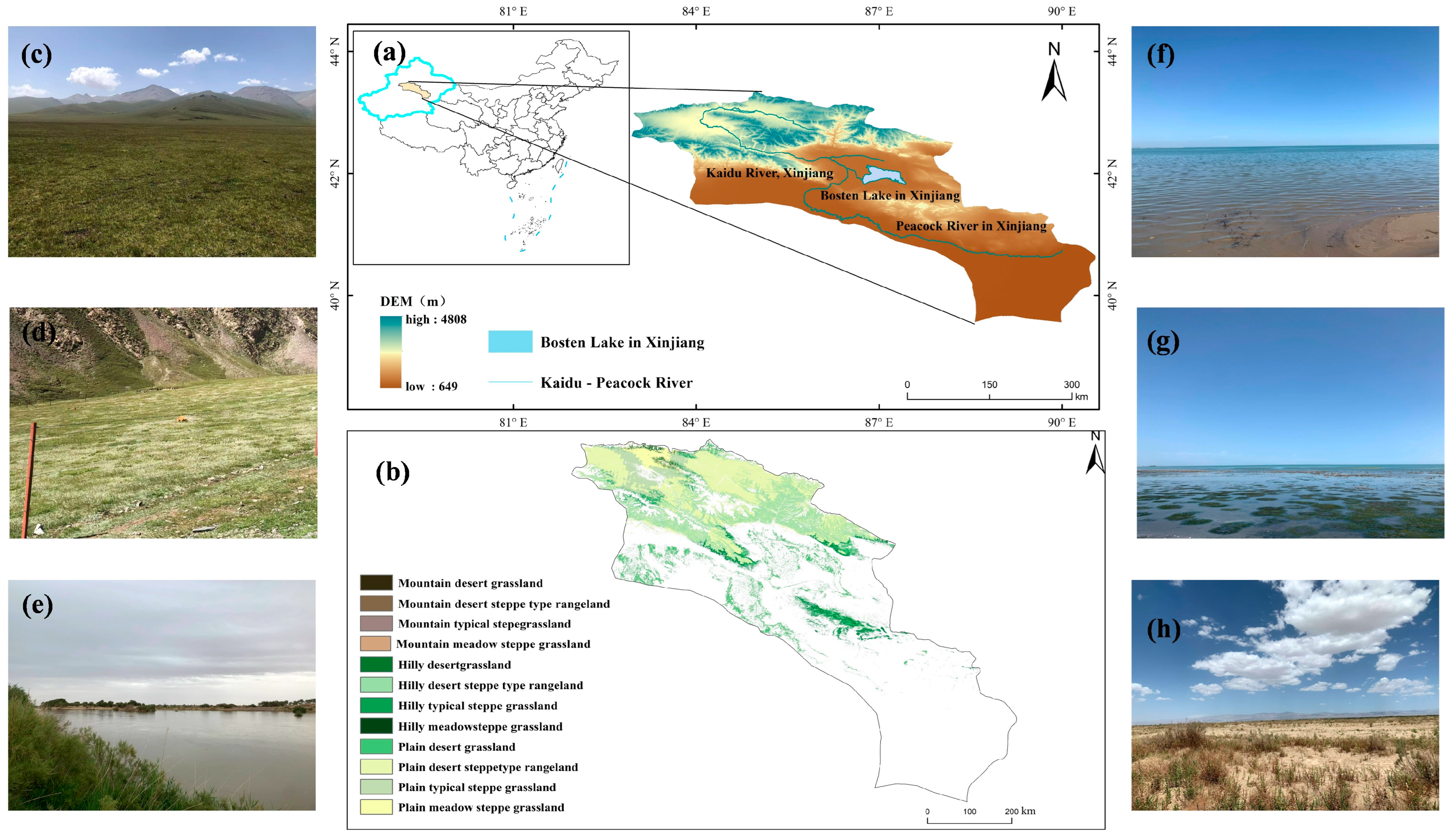
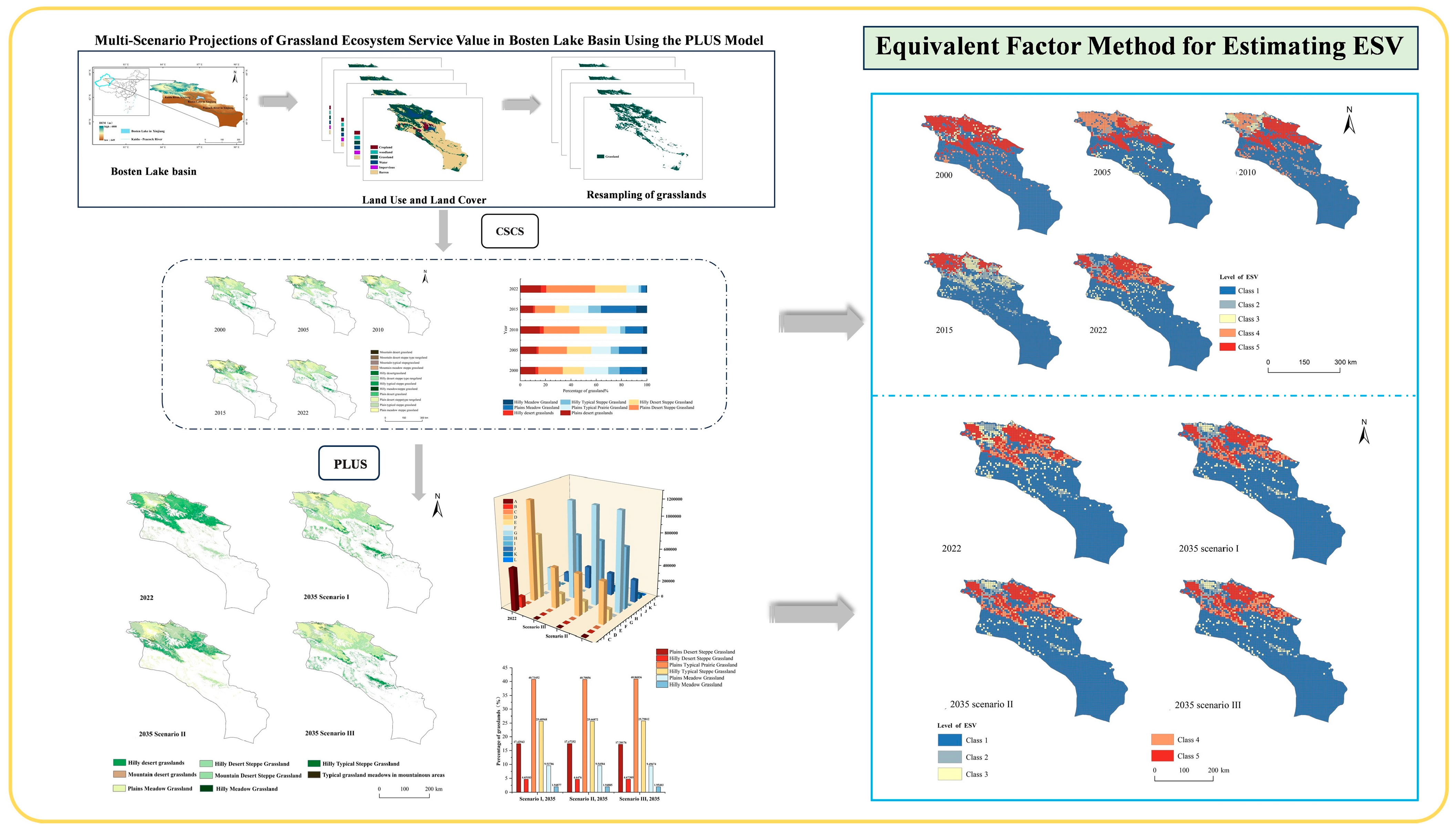
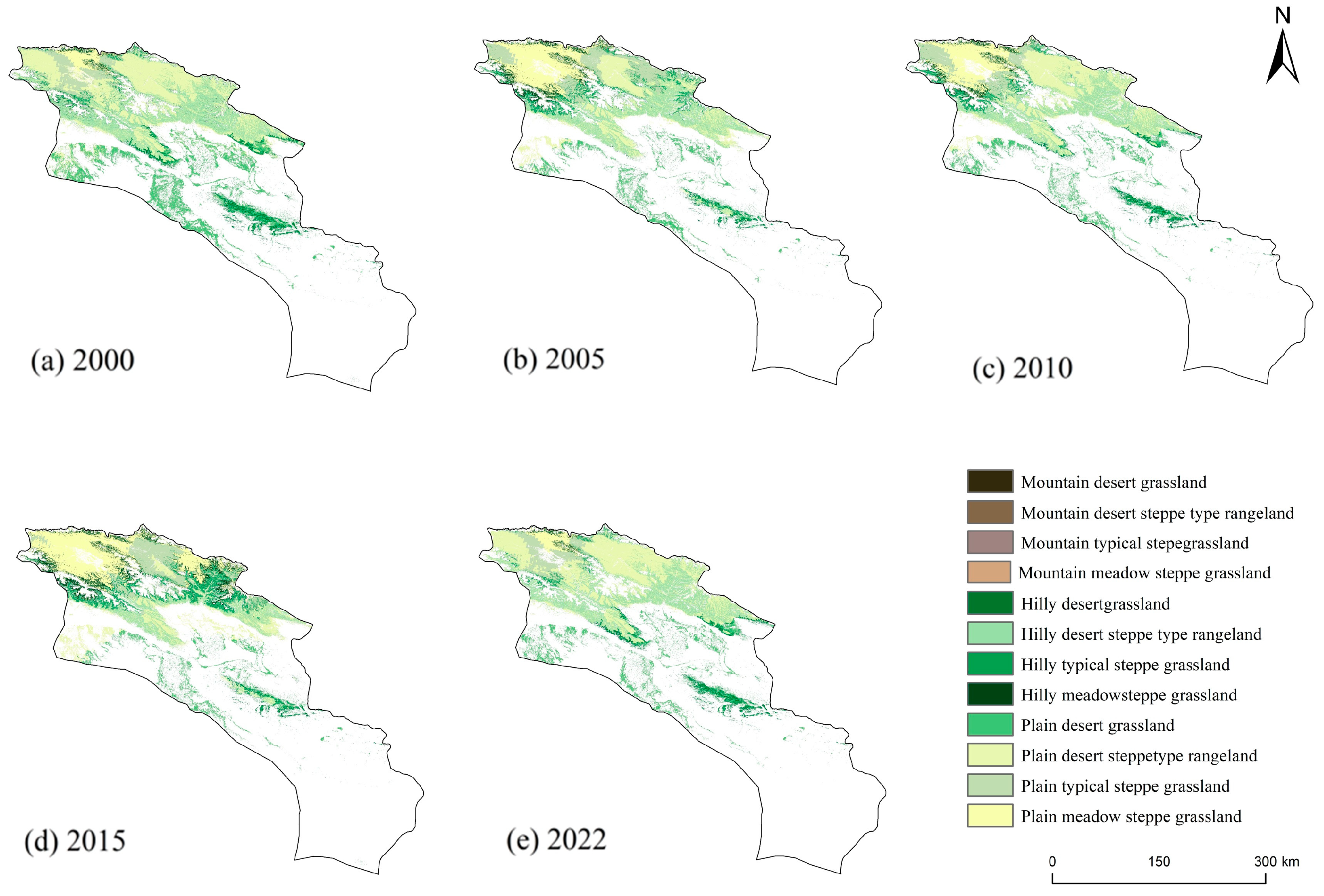

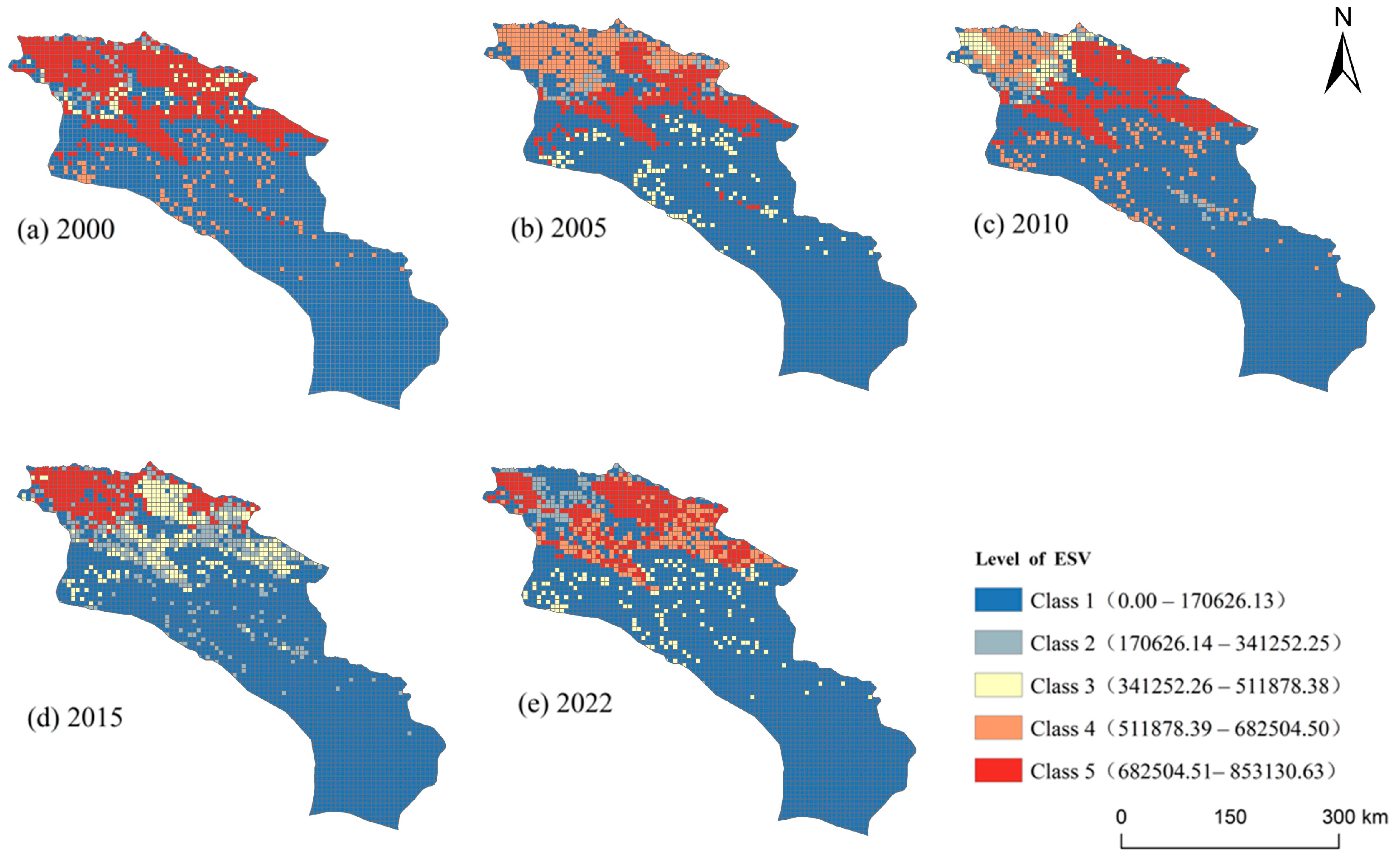

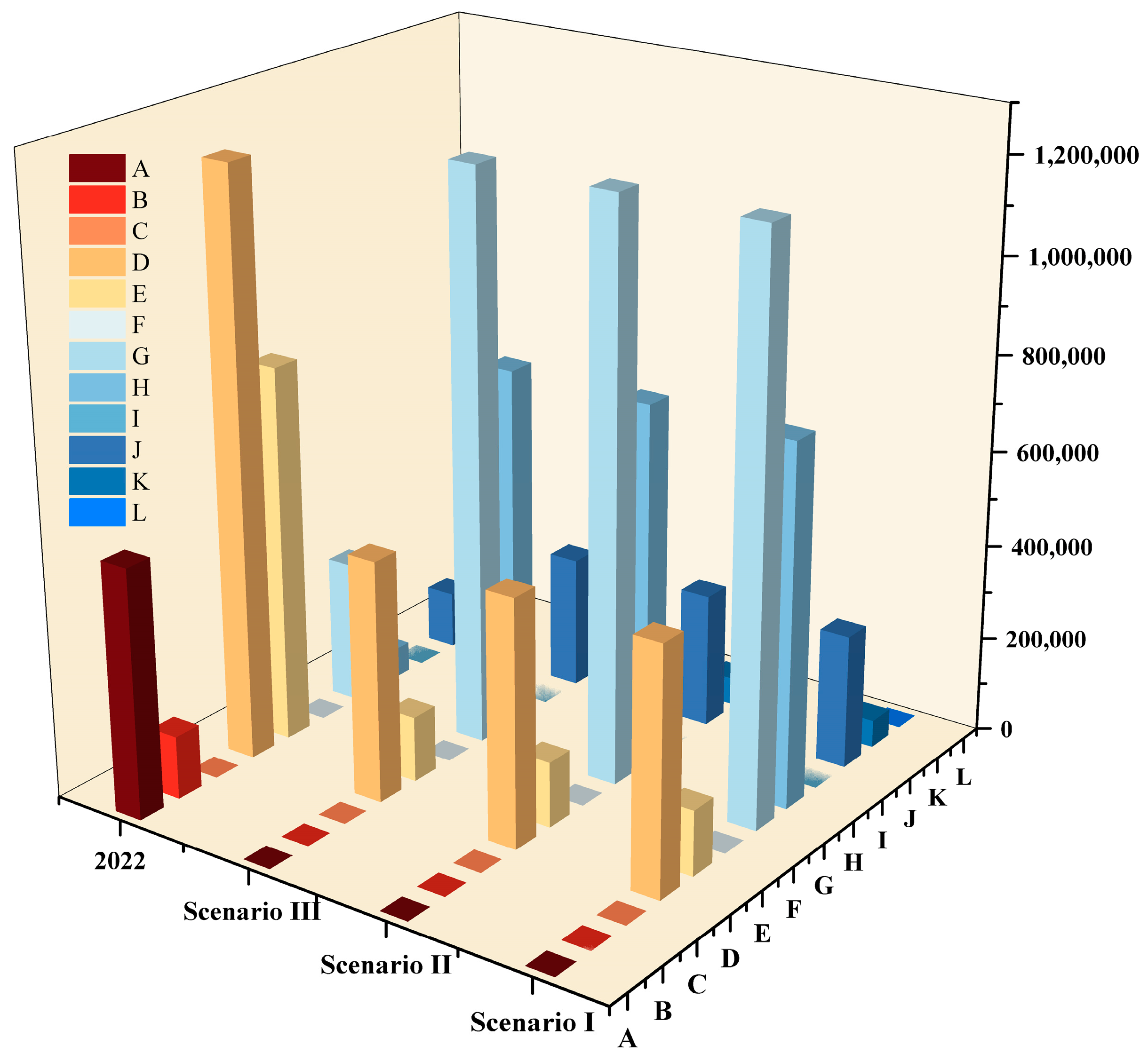
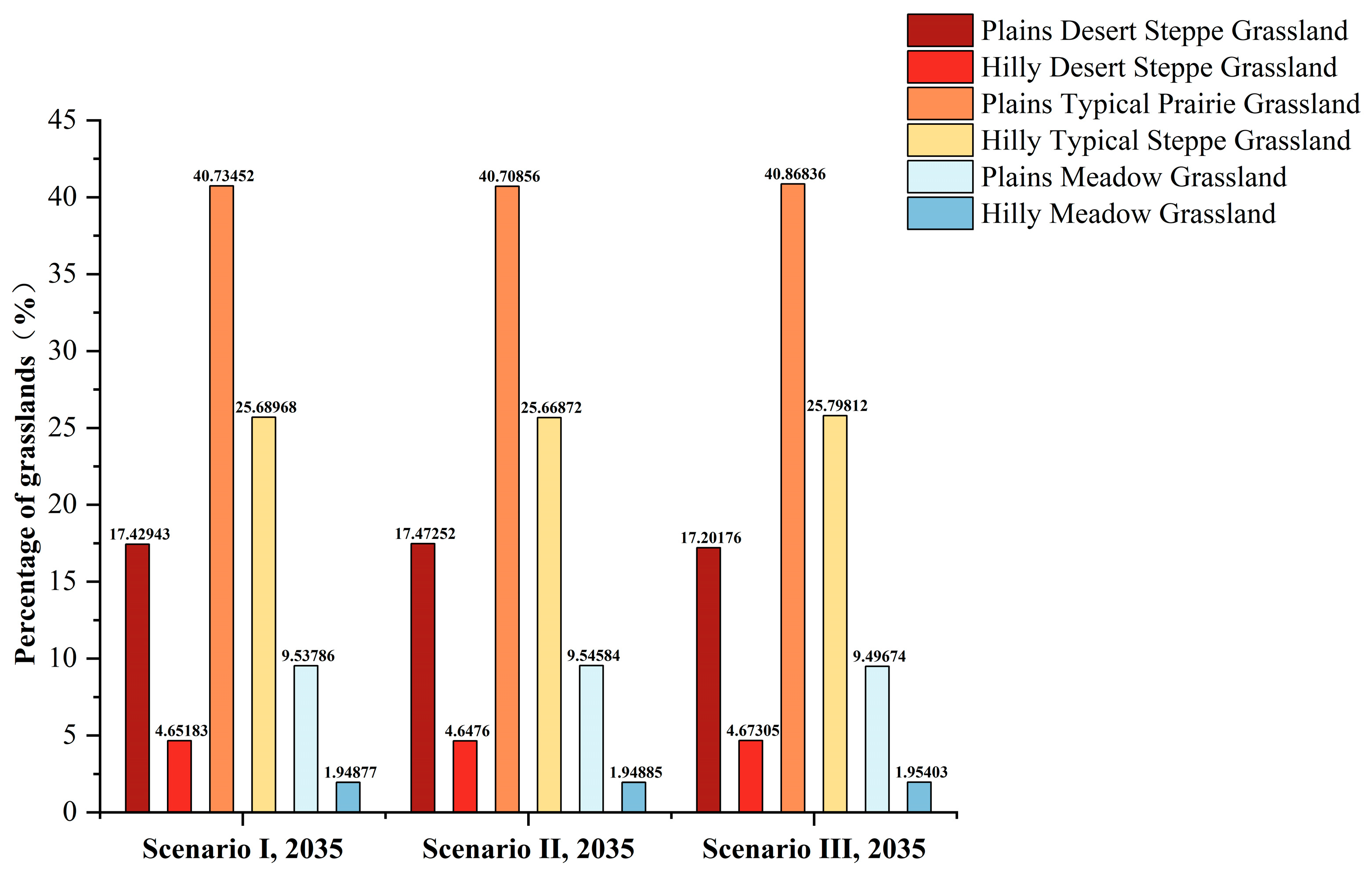

| Data Type | Accuracy/Format | Data Source |
|---|---|---|
| Land use data | 30 m | Jie Yang, and Xin Huang. (2023) [15]. The 30 m annual land cover datasets and its dynamics in China from 1985 to 2022 [dataset]. In Earth System Science Data |
| GDP | Text txt | “Xinjiang Statistical Yearbook” “Xinjiang Production and Construction Corps Statistical Yearbook” |
| Population spatial distribution km grid data, meteorological data such as precipitation and temperature | 1 km | National Climatic Data Center (http://data.cma.cn/, accessed on 20 October 2024) |
| 1:1,000,000 administrative divisions data | vector data | National Catalogue Service for Geographic Information (https://www.webmap.cn/main.do?method=index, accessed on 24 October 2024) |
| 1:250,000 national basic geographic data | vector data | National Catalogue Sevice For Geographic Information (https://www.webmap.cn, accessed on 25 October 2024) |
| The DEM data | 30 m | Geospatial Data Cloud (http://www.gscloud.cn, accessed on 15 October 2024) |
| Prices of China’s major grain varieties | Text txt | National Food and Strategic Reserves Administration (http://www.lswz.gov.cn/, accessed on 6 November 2024) |
| Grassland Type | 2000 | 2005 | 2010 | 2015 | 2022 | |||||
|---|---|---|---|---|---|---|---|---|---|---|
| Area /hm2 | Share /% | Area/hm2 | Share /% | Area/hm2 | Share/% | Area/hm2 | Share /% | Area/hm2 | Share /% | |
| Plain desert grasslands | 391,054.59 | 12.14963 | 421,230.33 | 13.02980 | 496,289.7 | 15.59840 | 327,248.46 | 10.21222 | 523,698.03 | 16.48629 |
| Hilly desert grasslands | 70,175.43 | 2.18027 | 50,440.23 | 1.56025 | 96,863.49 | 3.04442 | 45,946.53 | 1.43382 | 132,330.6 | 4.16584 |
| Mountain desert grasslands | 38.52 | 0.00120 | 18.09 | 0.00056 | 50.85 | 0.00160 | 13.59 | 0.00042 | 58.23 | 0.00183 |
| Plain desert steppe grassland | 626,179.41 | 19.45470 | 727,985.43 | 22.51856 | 894,670.65 | 28.11952 | 512,128.26 | 15.98165 | 1,223,506.62 | 38.51664 |
| Hilly desert steppe grassland | 532,913.04 | 16.55702 | 616,398.57 | 19.06688 | 686,789.46 | 21.58581 | 352,240.47 | 10.99213 | 789,698.07 | 24.86012 |
| Mountain desert steppe grassland | 155.88 | 0.00484 | 170.28 | 0.00527 | 145.17 | 0.00456 | 151.02 | 0.00471 | 156.06 | 0.00491 |
| Plain typical prairie grassland | 621,846.72 | 19.32009 | 499,405.23 | 15.44796 | 343,391.94 | 10.79282 | 487,943.1 | 15.22692 | 298,924.92 | 9.41032 |
| Hilly typical steppe grassland | 290,452.68 | 9.02404 | 210,958.11 | 6.52551 | 127,787.49 | 4.01636 | 320,992.65 | 10.01700 | 63994.77 | 2.01459 |
| Typical grassland meadows in mountainous areas | 12.69 | 0.00039 | 9.54 | 0.00030 | 92,376.27 | 0.00045 | 32.31 | 0.00101 | 7.92 | 0.00025 |
| Plain meadow grassland | 556,784.64 | 17.29868 | 576,142.02 | 17.82163 | 443,286 | 13.93249 | 888,738.48 | 27.73427 | 118,948.23 | 3.74455 |
| Hilly meadow grassland | 129,022.29 | 4.00858 | 130,054.95 | 4.02295 | 92,376.27 | 2.90339 | 269,025.03 | 8.39529 | 25,241.94 | 0.79463 |
| Mountain meadow grassland | 17.64 | 0.00055 | 11.07 | 0.00034 | 5.31 | 0.00017 | 17.73 | 0.00055 | 0.63 | 0.00002 |
| Grassland Type | 2000–2005 | 2005–2010 | 2010–2015 | 2015–2022 | ||||
|---|---|---|---|---|---|---|---|---|
| Magnitude of Change/hm2 | Rate of Change /% | Magnitude of Change /hm2 | Rate of Change /% | Magnitude of Change /hm2 | Rate of Change /% | Magnitude of Change /hm2 | Rate of Change /% | |
| Plain desert grasslands | 391,054.59 | 7.72 | 75,059 | 17.82 | −169,041 | −34.06 | 196,450 | 60.03 |
| Hilly desert grasslands | 70,175.43 | 16.26 | 166,685 | 22.90 | −382,542 | −42.76 | 711,378 | 138.91 |
| Mountain desert grasslands | 38.52 | −19.69 | −156,013 | −31.24 | 144,551 | 42.10 | −189,018 | −38.74 |
| Plain desert steppe grassland | 626,179.41 | 3.48 | −132,856 | −23.06 | 445,452 | 100.49 | −769,790 | −86.62 |
| Hilly desert steppe grassland Hilly desert steppe grassland | 532,913.04 | −28.12 | 46,423 | 92.04 | −50,917 | −52.57 | 86,384 | 188.01 |
| Mountain desert steppe grassland | 155.88 | 15.67 | 70,391 | 11.42 | −334,549 | −48.71 | 437,458 | 124.19 |
| Plain typical prairie grassland | 621,846.72 | −27.37 | −83,171 | −39.43 | 193,205 | 151.19 | −256,998 | −80.06 |
| Hilly typical steppe grassland | 290,452.68 | 0.80 | −37,679 | −28.97 | 176,649 | 191.23 | −243,783 | −90.62 |
| Typical grassland meadows in mountainous areas | 12.69 | −53.04 | 33 | 181.09 | −37 | −73.27 | 45 | 328.48 |
| Plain meadow grassland | 556,784.64 | 9.24 | −25 | −14.75 | 6 | 4.03 | 5 | 3.34 |
| Hilly meadow grassland | 129,022.29 | −24.82 | 5 | 50.94 | 18 | 124.38 | −24 | −75.49 |
| Mountain meadow grassland | 17.64 | −37.24 | −6 | −52.03 | 12 | 233.90 | −17 | −96.45 |
| Grassland Type | 2000–2005 | 2005–2010 | 2010–2015 | 2015–2022 | ||||
|---|---|---|---|---|---|---|---|---|
| ESV | Change/% | ESV | Change/% | ESV | Change /% | ESV | Change/% | |
| Plain desert grassland | 4.1113 | 7.16 | 10.2264 | 15.12 | −23.0308 | −51.66 | 26.7650 | 37.51 |
| Hilly desert grasslands | −2.6888 | −39.13 | 6.3249 | 47.93 | −6.9371 | −110.82 | 11.7693 | 65.28 |
| Mountain desert grasslands | −0.0028 | −112.94 | 0.0045 | 64.42 | −0.0051 | −274.17 | 0.0061 | 76.66 |
| Plain desert steppe grassland | 13.8704 | 13.98 | 22.7098 | 18.63 | −52.1190 | −74.70 | 96.9209 | 58.14 |
| Hilly desert steppe grassland | 11.3744 | 13.54 | 9.5903 | 10.25 | −45.5802 | −94.98 | 59.6009 | 55.40 |
| Mountain desert steppe grassland | 0.0020 | 8.46 | −0.0034 | −17.30 | 0.0008 | 3.87 | 0.0007 | 3.23 |
| Plain typical prairie grassland | −16.6819 | −24.52 | −21.2558 | −45.43 | 19.6942 | 29.62 | −25.7526 | −63.23 |
| Hilly typical steppe grassland | −10.8306 | −37.68 | −11.3315 | −65.09 | 26.3230 | 60.19 | −35.0144 | −401.59 |
| Typical grassland meadows in mountainous areas | −0.0004 | −33.02 | 12.5844 | 99.99 | −12.5813 | −285806.13 | −0.0033 | −307.95 |
| Plain meadow grassland | 2.6373 | 3.36 | −18.1008 | −29.97 | 60.6901 | 50.12 | −10.4879 | −647.16 |
| Hilly meadow grassland | 0.1407 | 0.79 | −5.1335 | −40.79 | 24.0673 | 65.66 | −33.2139 | −965.79 |
| Mountain meadow grassland | −0.0009 | −59.35 | −0.0008 | −108.47 | 0.0017 | 70.05 | −0.0023 | −2714.29 |
| Total | 1.9306 | 0.44 | 5.6144 | 1.27 | −9.4764 | −2.12 | −3.8028 | −0.87 |
| Grassland Type | 2035 Scenario I | 2035 Scenario II | 2035 Scenario III | |||
|---|---|---|---|---|---|---|
| Area /hm2 | Rate of Change /% | Area /hm2 | Rate of Change /% | Area /hm2 | Rate of Change /% | |
| Plain desert grasslands | 29 | −99.9945 | 29 | −99.9945 | 29 | −99.9945 |
| Hilly desert grasslands | 11 | −99.9917 | 11 | −99.9917 | 11 | −99.9917 |
| Mountain desert grasslands | 50 | −14.1336 | 50 | −14.1336 | 50 | −14.1336 |
| Plain desert steppe grassland | 513,134 | −58.0604 | 514,864 | −57.9190 | 504065 | −58.8016 |
| Hilly desert steppe grassland | 136,953 | −82.6575 | 136,951 | −82.6578 | 136935 | −82.6598 |
| Mountain desert steppe grassland | 141 | −9.6501 | 141 | −9.6501 | 141 | −9.6501 |
| Plain typical prairie grassland | 1,199,251 | 301.1880 | 1,199,562 | 301.2921 | 1,197,570 | 300.6257 |
| Hilly typical steppe grassland | 756,321 | 1081.8481 | 756,382 | 1081.9435 | 755,965 | 1081.2918 |
| Typical grassland meadows in mountainous areas | 2 | −74.7475 | 2 | −74.7475 | 2 | −74.7475 |
| Plain meadow grassland | 280,801 | 136.0699 | 281,288 | 136.4793 | 278,284 | 133.9539 |
| Hilly meadow grassland | 57,373 | 127.2924 | 57,427 | 127.5063 | 57,259 | 126.8407 |
| Mountain meadow grassland | — | — | — | — | — | — |
| Grassland Type | 2035 Scenario I | 2035 Scenario II | 2035 Scenario III | |||
|---|---|---|---|---|---|---|
| ESV | Change % | ESV | Change % | ESV | Change % | |
| Plain desert grasslands | 0.0040 | −18057.55 | 0.0040 | −18,057.55 | 0.0040 | −18,057.55 |
| Hilly desert grasslands | 0.0015 | −12029.05 | 0.0015 | −12,029.05 | 0.0015 | −12,029.05 |
| Mountain desert grasslands | 0.0068 | −0.16 | 0.0068 | −0.16 | 0.0068 | −0.16 |
| Plain desert steppe grassland | 69.9113 | −1.38 | 70.1470 | −1.38 | 70.1470 | −1.43 |
| Hilly desert steppe grassland | 18.6590 | −4.77 | 18.6587 | −4.77 | 18.6587 | −4.77 |
| Mountain desert steppe grassland | 0.0192 | −0.11 | 0.0192 | −0.11 | 0.0192 | −0.11 |
| Plain typical prairie grassland | 163.3905 | 0.75 | 163.4329 | 0.75 | 163.4329 | 0.75 |
| Hilly typical steppe grassland | 103.0440 | 0.92 | 103.0524 | 0.92 | 103.0524 | 0.92 |
| Typical grassland meadows in mountainous areas | 0.0003 | −2.96 | 0.0003 | −2.96 | 0.0003 | −2.96 |
| Plain meadow grassland | 38.2574 | 0.58 | 38.3237 | 0.58 | 38.3237 | 0.57 |
| Hilly meadow grassland | 7.8167 | 0.56 | 7.8241 | 0.56 | 7.8241 | 0.56 |
| Mountain meadow grassland | — | — | — | — | — | — |
| Total | 401.1107 | −30,093.19 | 401.4706 | −30,093.18 | 399.2367 | −30,093.24 |
Disclaimer/Publisher’s Note: The statements, opinions and data contained in all publications are solely those of the individual author(s) and contributor(s) and not of MDPI and/or the editor(s). MDPI and/or the editor(s) disclaim responsibility for any injury to people or property resulting from any ideas, methods, instructions or products referred to in the content. |
© 2025 by the authors. Licensee MDPI, Basel, Switzerland. This article is an open access article distributed under the terms and conditions of the Creative Commons Attribution (CC BY) license (https://creativecommons.org/licenses/by/4.0/).
Share and Cite
Zhang, Z.; Li, Z.; Zhu, Z.; Wang, Y. Accounting of Grassland Ecosystem Assets and Assessment of Sustainable Development Potential in the Bosten Lake Basin. Sustainability 2025, 17, 3460. https://doi.org/10.3390/su17083460
Zhang Z, Li Z, Zhu Z, Wang Y. Accounting of Grassland Ecosystem Assets and Assessment of Sustainable Development Potential in the Bosten Lake Basin. Sustainability. 2025; 17(8):3460. https://doi.org/10.3390/su17083460
Chicago/Turabian StyleZhang, Zhichao, Zhoukang Li, Zhen Zhu, and Yang Wang. 2025. "Accounting of Grassland Ecosystem Assets and Assessment of Sustainable Development Potential in the Bosten Lake Basin" Sustainability 17, no. 8: 3460. https://doi.org/10.3390/su17083460
APA StyleZhang, Z., Li, Z., Zhu, Z., & Wang, Y. (2025). Accounting of Grassland Ecosystem Assets and Assessment of Sustainable Development Potential in the Bosten Lake Basin. Sustainability, 17(8), 3460. https://doi.org/10.3390/su17083460





